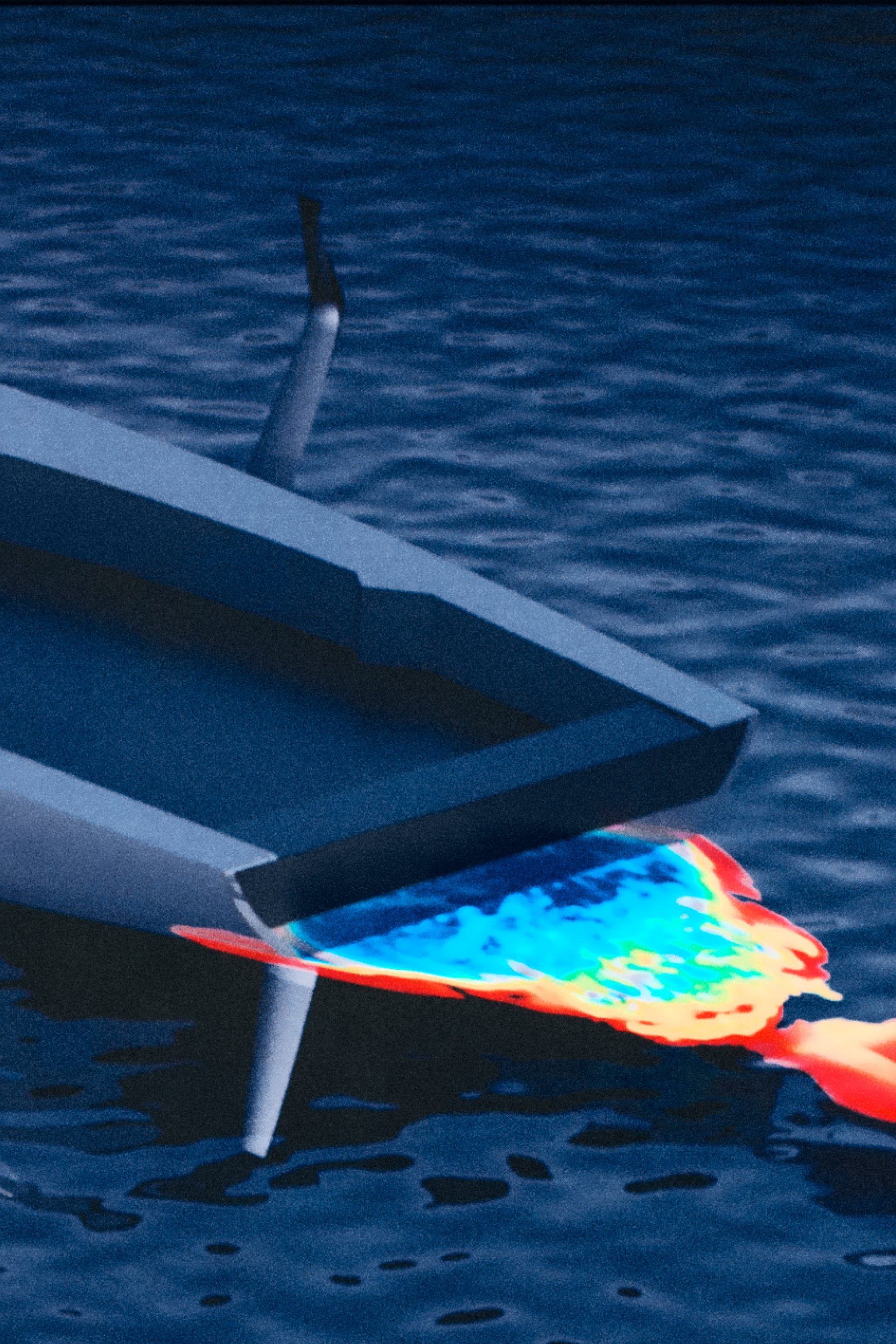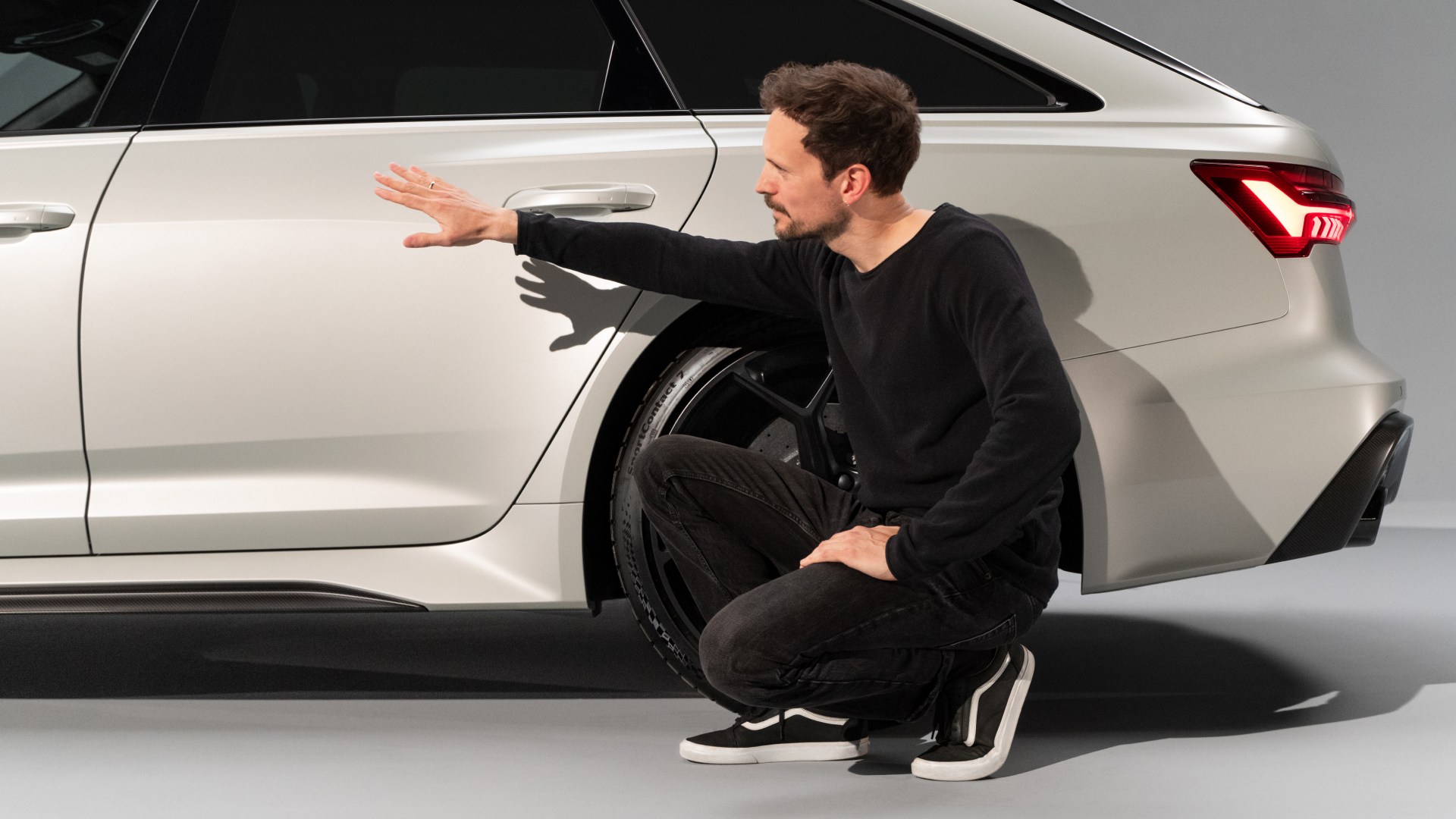Aesthetics x Performance = Perfection
Marc Lichte, Head of Design at AUDI AG, is every bit the sailor and has notched up three wins in his class at Kiel Week. Where does he draw similarities between boats and vehicles?

One thing is important when it comes to the design of a vehicle or a boat: At the rear, the flow should break off in a defined way. Marc Lichte looks at flow simulations on a digital powerwall in a studio of Audi’s design department.
One thing is important when it comes to the design of a vehicle or a boat: At the rear, the flow should break off in a defined way. Marc Lichte looks at flow simulations on a digital powerwall in a studio of Audi’s design department.
A passionate yachtsman since childhood – and a passionate vehicle designer who has been defining Audi’s design language for almost a decade. This man’s world revolves around shapes. Shapes he moves on and shapes he creates. Boat shapes that flow elegantly through the water, and vehicle shapes that efficiently cut through the wind. So, the question is: Does Marc Lichte dedicate his life to aesthetics or to flow? “It’s not a question of either/or. I shall be happy when both come together in perfection. For me, sailing is always performance. I only sail fast boats, very fast boats. But my boats must always be extremely aesthetic, every single one of them. And this is also true for Audi: One of Audi’s core values is performance. And maximum aesthetics, of course.”
A brief meeting with Marc Lichte in an Audi Design Studio in Ingolstadt right before Kiel Week, one of the world's largest sailing events. Marc Lichte’s home port had been the Kiel Fjord for many years. This year, he will sail his new yacht, a ten-meter ocean racer, at Kiel Week. Later, Marc Lichte has an appointment with Dr Moni Islam, Head of Development Aerodynamics/Aeroacoustics at Audi (see video). But there is still time to talk about boat design and vehicle design, about efficiency, flow, aerodynamics – and also about perfection. Because that’s what inspires Marc Lichte: getting as close to perfection as possible. “Performance paired with maximum aesthetics,” Lichte continues. “And performance also means: optimisation down to the last detail,” he emphasises to make it very clear that there is no room for compromise, none whatsoever. Maximum expectations. Of himself. Of aesthetics. Of performance. Of everything he creates, everything that surrounds him.

Feeling the wind to make the yacht go fast: Marc Lichte is every bit the sailor.

A distinctive stall at the stern of the boat reduces turbulence and thus enhances performance.
Feeling the wind to make the yacht go fast: Marc Lichte is every bit the sailor.
A distinctive stall at the stern of the boat reduces turbulence and thus enhances performance.
“Top aerodynamics is a core component of Audi’s DNA and therefore its design language.”
Marc Lichte
Aesthetic performance of a car: Audi’s aerodynamicists came up with the idea of so-called “air curtains” at the sides of the car’s nose; these are air intakes that direct the air from the front into the wheel arches to optimise the flow. Marc Lichte comments: “This input from the wind tunnel is an ingenious aerodynamic detail. We apply this to the formal design of all our electric vehicles. It’s a key feature that signals: This car is efficient.”
At a very early stage in the development of a new vehicle, Audi designers will place different proportional models into the wind tunnel; the design with the best drag coefficient will go into series production. “Aerostaetics” is what they call it amongst themselves – aesthetics that evolve from the wind tunnel.

Marc Lichte optimises every boat down to the last detail. Carbon sails not only enhance performance, but also meet Lichte’s demand for maximum aesthetics.
Marc Lichte optimises every boat down to the last detail. Carbon sails not only enhance performance, but also meet Lichte’s demand for maximum aesthetics.
Lichte, every bit the sailor, points out that the shape of a boat can, of course, also be optimised to enable the best possible flow: “We may use wind tunnels in vehicle development, but be use towing tanks in the development of performance boats.” The designer knows the ropes when it comes to the similarities between good boat design and good vehicle design: “The basis of good design is proportion. This is true both for a boat and for a car.”
The ideal boat design according to Lichte: the flatter the hull, the more aesthetically pleasing, it should be extremely slim, with little volume in the forecastle, and the focus should be placed on the widest point, with a defined, trailing edge at the stern of the boat. “It should create a harmonious look.” And he adds: “It’s not much different when we are looking at cars: a flat car is more efficient, more aerodynamic. Prominent lines create a beautiful shape. And the aerodynamic flow should remain on the sides and the roof for as long as possible – and finally break off in a maximally defined way.” Length determines speed – this is true both for the design of a boat and of a vehicle.
And before Marc Lichte has to leave for his appointment with the aerodynamics specialist, we have to ask one last question: How do you make efficiency more aesthetic? “My philosophy is: If form and function – and function includes good aerodynamics – are in perfect harmony, it’s a good design. Form follows function. It’s what drives us all here at Audi.”
Marc Lichte, Head of Design at AUDI AG, is meeting with Dr Moni Islam, Head of Development Aerodynamics/Aeroacoustics at Audi.







